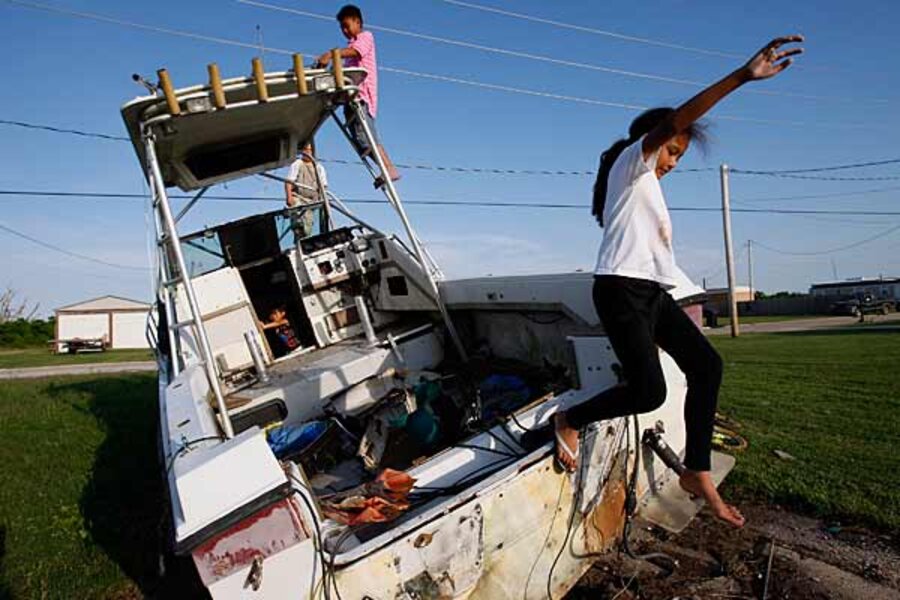Active hurricane season ahead: too soon to tell oil spill's impact
The 2010 Atlantic hurricane season, which begins June 1, is shaping up to be an active one.
That's the assessment from the National Oceanic and Atmospheric Administration's Climate Prediction Center (CPC) in Camp Springs, Md., which released its seasonal forecast Thursday.
The assessment dovetails with several other seasonal projections, including an outlook issued in April by researchers at Colorado State University who have pioneered seasonal hurricane forecasting for the Atlantic basin.
The prospect for a higher-than-normal number of tropical cyclones is taking on added gravitas along a Gulf coast already grappling with the effects of a major offshore oil blow-out that began April 20.
During a press briefing lay out the seasonal outlook, NOAA Administrator Jane Lubchenco acknowledged that a hurricane's storm surge could drive any residual oil from the blow-out into coastal wetlands. But, she added, much depends on a storm's track.
Because high winds from hurricanes also lead to significant upwelling of colder water from deeper beneath the surface, any oil droplets still suspended in those waters also could return to the surface and carry ashore. And any oil on the bottom in near-shore areas could get stirred up and transported inland as well.
Still, given the risk hurricanes pose to people and property, FEMA Administrator Craig Fugate noted that if stirred-up oil was the only issue a hurricane left behind, "I'm a happy person."
More named storms than average
During the six-month season, CPC forecasters say they anticipate between 14 and 23 named storms – storms that reach at least tropical-storm strength. Of those, eight to 14 are expected to become hurricanes. From three to seven of these could become major hurricanes, with winds exceeding 111 miles an hour.
This compares with a long-term average of 11 named storms per season, with six becoming hurricanes and two becoming major hurricanes.
For their part, Philip Klotzbach and William Gray, atmospheric scientists at Colorado State University in Fort Collins, are calling for 15 named storms, of which eight become hurricanes and four become major hurricanes. The team is expected to update its April forecast next week.
Among the factors at play in determining the season's intensity: warmer-than-normal sea-surface temperatures in the tropical Atlantic region where storms form; and a shift from El Nino conditions in the tropical Pacific to either neutral or El Nino's opposite, La Nina conditions, as the season progresses.
The warm surface waters, already at record highs, provide the energy for the storms. The shift away from El Nino conditions in the Pacific weakens wind shear – differences in wind speed with altitude – that tend to suppress hurricane formation in the Atlantic.
"At present, we are in a neutral state," says Gerry Bell, the CPC's lead seasonal hurricane forecaster. "But conditions are becoming increasingly favorable for a La Nina to develop."
Storms' effect on underwater pipelines
Concerns over the effect of hurricanes on Gulf oil resources extend beyond the Deepwater Horizon blow-out to the extensive network of oil and gas pipelines that snake along the bottom.
Scientists at the US Naval Research Laboratory at NASA's Stennis Space Center in Mississippi have found that strong hurricanes have the potential to introduce unexpectedly high stresses on sea floors as deep as 300 feet. It appears to be the first time scientists have made such direct measurements of a major hurricane's effect on the ocean bottom at such depths.
The team was focused on trying to reduce the risk of pipeline damage and outright failures that hurricanes in principle pose.
In an upcoming issue of the journal Geophysical Research Letters, Hemantha Wijesekera and colleagues report sea-floor stress measurements taken during hurricane Ivan in 2004. It was a category 4 storm (category 5 is the strongest) when it passed over moorings the team already had in place on the outer continental shelf, at depths of 200 and 300 feet.
The scientists found that at 200 feet, the stresses induced by currents and the deep reach of wave action as the storm passed over were 100 times those of pre-storm levels. The same stresses at 300 feet were about half the level measured at 200 feet. Moreover, a kind of sloshing action continued at those depths, maintaining the high stress levels for roughly a week after the storm passed.
The team stops short of making direct comparisons between the stresses they measured and design specifications of undersea pipelines. Still, they caution that these "critical bottom stresses on the outer shelf must be considered in the engineering design of structures on the bottom and in determining where pipe lines should be buried and not just laid on top the ocean floor."
Related:





